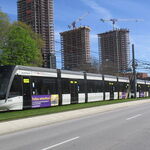Euphoria
Active Member
Sorry for the multiple posts, but I found this article pertinent regarding U.S. toll tunnels:
5 Highest Tunnel Tolls
 Lincoln and Holland Tunnel
Lincoln and Holland Tunnel
Where: New York Toll: $13 collected one-way Length: 7,482 ft and 8,558 ft respectively
Did you know that there are only 12 toll-collecting tunnels in the United States, and 4 of them are in New York City? Not surprisingly, two of them are tied for the most expensive. Entering Manhattan by the Lincoln or Holland tunnel will set you back $13 cash. Fortunately, the ride back is free.
 Anton Anderson Memorial Tunnel
Anton Anderson Memorial Tunnel
Where: Alaska Toll: $12 Length: 2.5 Miles
The close runner-up for most expensive toll tunnel is the Anton Anderson Memorial Tunnel in Whittier, Alaska. At 13,300 ft, the AAMT or simply “Whittier Tunnel” as it is sometimes called, is the second longest tunnel in North America. Whittier collects a $12 toll per car one-way, in the east bound direction.
 Fort McHenry Tunnel
Fort McHenry Tunnel
Where: Maryland Toll: $8 round trip Length: 1.5 Miles
The Fort McHenry Tunnel passes 1.5 miles, or 7,920 feet underneath Patapsco River in Maryland. Over 44 million cars pass through the tunnel every year, paying $4 each way. You do the math.
 Brooklyn Battery Tunnel and Queens Midtown Tunnel
Brooklyn Battery Tunnel and Queens Midtown Tunnel
Where: New York Toll: $7.50 only one-way Length: 9,117 ft and 6,414 ft respectively
Manhattan doubles its population during business days from everyone who commutes for work. To support that amount of traffic, the city has an extensive network of bridges and tunnels. The Brooklyn Battery tunnel connects Brooklyn to the southernmost tip of Manhattan. It’s also the longest underwater tunnel in North America. The Queens Midtown tunnel, where Tommy Lee Jones and Will Smith rode upside-down in a Ford Crown Vic in the movie Men In Black, connects Queens and and Midtown. The both carry hefty one-way tolls of $7.50.
Final Thoughts
Although the original purpose of collecting tolls was to pay for the construction and maintenance of the road structure itself, that’s no longer the case. The MTA claims that 60% of the revenue from tolls goes towards subsidizing mass transit in New York City. Furthermore, the New Jersey Turnpike collects more revenue from tolls than any other road in North America, nearly $1 Billion dollars in 2012. That’s more than the entire cost to build the Fort McHenry tunnel in the 1980’s.
5 Highest Tunnel Tolls
 Lincoln and Holland Tunnel
Lincoln and Holland TunnelWhere: New York Toll: $13 collected one-way Length: 7,482 ft and 8,558 ft respectively
Did you know that there are only 12 toll-collecting tunnels in the United States, and 4 of them are in New York City? Not surprisingly, two of them are tied for the most expensive. Entering Manhattan by the Lincoln or Holland tunnel will set you back $13 cash. Fortunately, the ride back is free.
 Anton Anderson Memorial Tunnel
Anton Anderson Memorial TunnelWhere: Alaska Toll: $12 Length: 2.5 Miles
The close runner-up for most expensive toll tunnel is the Anton Anderson Memorial Tunnel in Whittier, Alaska. At 13,300 ft, the AAMT or simply “Whittier Tunnel” as it is sometimes called, is the second longest tunnel in North America. Whittier collects a $12 toll per car one-way, in the east bound direction.
 Fort McHenry Tunnel
Fort McHenry TunnelWhere: Maryland Toll: $8 round trip Length: 1.5 Miles
The Fort McHenry Tunnel passes 1.5 miles, or 7,920 feet underneath Patapsco River in Maryland. Over 44 million cars pass through the tunnel every year, paying $4 each way. You do the math.
 Brooklyn Battery Tunnel and Queens Midtown Tunnel
Brooklyn Battery Tunnel and Queens Midtown TunnelWhere: New York Toll: $7.50 only one-way Length: 9,117 ft and 6,414 ft respectively
Manhattan doubles its population during business days from everyone who commutes for work. To support that amount of traffic, the city has an extensive network of bridges and tunnels. The Brooklyn Battery tunnel connects Brooklyn to the southernmost tip of Manhattan. It’s also the longest underwater tunnel in North America. The Queens Midtown tunnel, where Tommy Lee Jones and Will Smith rode upside-down in a Ford Crown Vic in the movie Men In Black, connects Queens and and Midtown. The both carry hefty one-way tolls of $7.50.
Final Thoughts
Although the original purpose of collecting tolls was to pay for the construction and maintenance of the road structure itself, that’s no longer the case. The MTA claims that 60% of the revenue from tolls goes towards subsidizing mass transit in New York City. Furthermore, the New Jersey Turnpike collects more revenue from tolls than any other road in North America, nearly $1 Billion dollars in 2012. That’s more than the entire cost to build the Fort McHenry tunnel in the 1980’s.




